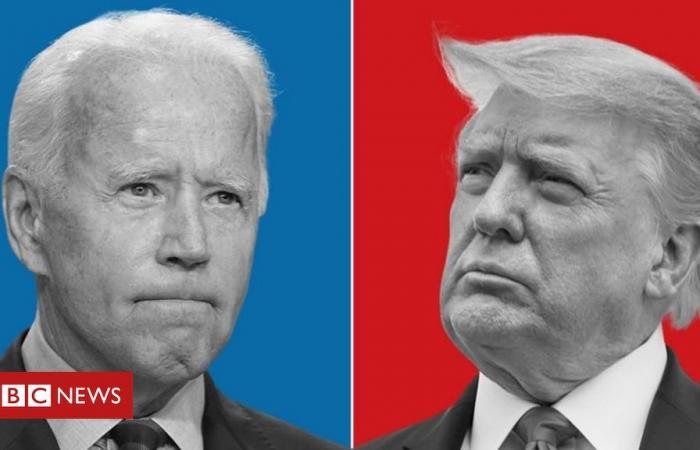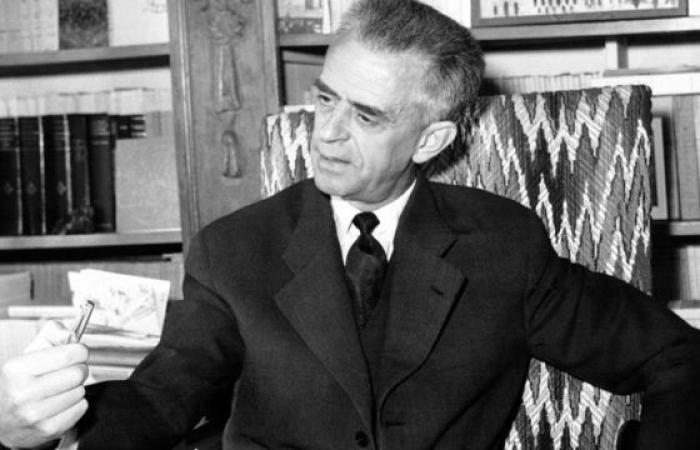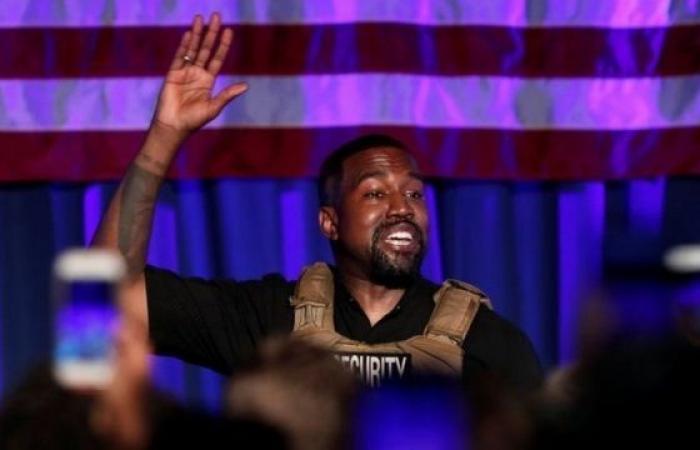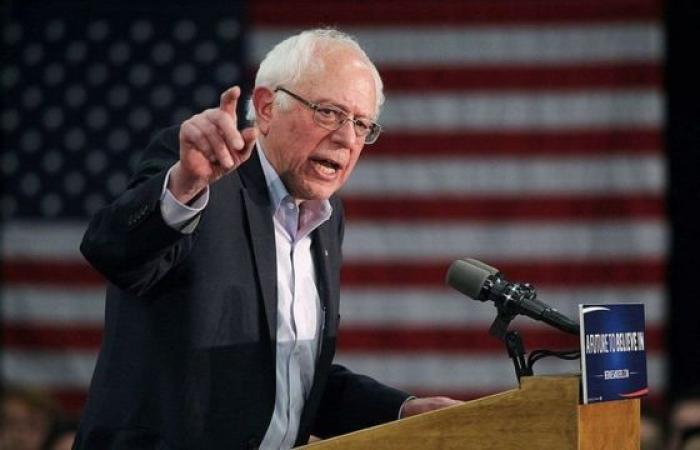- Pierina Pighi Bel (@PierinaPighi)
- BBC World News
2 hours ago
A Democrat or Republican will occupy the White House by 2024
In the presidential elections in the United States, a certainty persists over the years: the winner is always a Republican or Democratic candidate.
So it will be in the November 3 elections, and it has been so for more than 160 years, although other groups or independent candidates have competed against them to occupy the White House.
This entrenched bipartisanship can be explained in an old “law” of political science, the “Duverger law” by Maurice Duverger, the French sociologist who divulged the basis of this theory.
What does it say and to what extent does it actually occur?
Relative majority and single shift
Duverger published in 1951 the book Political parties, in which it states that a country’s voting system is decisive for it to be bipartisan or multiparty.
In his text, Duverger says that “majority voting and a turn tends towards party dualism”.
In other words, bipartisanship will be the norm in cases where to win the electoral process it is enough to obtain the largest number of votes, which is called simple or relative majority voting.
This system differs from those that provide for a second round among the most voted candidates if none exceeds the limit of the qualified majority (for example, 50% plus one or, as in Bolivia, 40% with ten points difference).

Credit, Getty Images
Maurice Duverger published the book ‘Political Parties’ in 1951
“The absence of a second round (…) mainly in the presidential election, is one of the historical reasons for the advent of bipartisanship and its maintenance”, says Duverger in his book.
Duverger points out that, in the United States, “traditional bipartisanship also coincides with the scrutiny of the majority in a round”.
The presidential election in the USA is indirect: the vote of the citizens serves to form the Electoral College, which is in charge of electing the president.
That is why we must understand the difference between the popular vote, which is made directly by the citizens, and the vote in the US Electoral College.
Why is voting indirect in the USA and how does the Electoral College work?
Each US state elects a certain number of the 538 members that make up the Electoral College. To win the Presidency, a candidate must obtain at least 270 of these electoral votes.
In 48 states and Washington DC, the candidate who obtains a simple majority of the popular vote obtains all representatives from the Electoral College. Only Maine and Nebraska are exceptions, as they also grant electoral votes to winners in each district.
Thus, the USA can be seen as a simple or relative majority system (one of the conditions that Duverger talks about): a single candidate wins all the state’s electoral votes and nothing is distributed between second or third place.
“There is no point in being second, voters are not divided,” Brian Gaines, a professor of political science at the University of Illinois, told BBC News Mundo, the BBC’s Spanish-language service.
“The bipartisan system was elevated to presidential elections thanks to the plurality component of the polling stations,” adds Gaines.

Credit, Getty Images
Ross Perot took a significant percentage of George H. Bush’s votes in 1992
For example, in 1992, independent candidate Ross Perot ran in the presidential election against Democrat Bill Clinton and Republican George HW Bush, and won 19% of the popular vote.
Perot was not well enough to win any electoral votes.
In addition to this school dynamic, there is no second round of presidential elections in the USA.
If no one reached 270 electoral votes – something that once happened in the United States – Congress would decide the election.
Helpful vote
This one-vote majority voting system has psychological effects on voters, notes Duverger in his book.
If a third party arises, “voters often understand that their votes will be lost if they vote for the third: hence their natural tendency to choose the least bad of their opponents, to avoid the success of the worst,” says the author.
“I think this (Duverger’s) law reflects very well what we see in the bipartisan system,” David Paleologos, director of the Center for Political Research at Suffolk University in the United States, told BBC News Mundo.
According to this theory, “with a proportional (voting) system, it would be enough to gain political support for 5%, 10%, 20% of the votes, but that does not happen in this country”, he adds.
The system “forces people to think in terms of two parties and prevents third-party candidates from receiving support because they receive no significant percentage,” says Paleologos.
So, small parties lose incentives to participate in elections.

Credit, Reuters
Rapper Kanye West will not be able to appear on ballot papers in all U.S. states
“Although there are always people who vote for a third party or write someone else’s name. It’s not that there are no other options,” says Paleologos. “There is not a single state that has only Biden or Trump. That’s what the polls say, but it is incorrect.”
But, in the end, according to the Duverger law, “voter behavior tends to conform to the electoral system,” says the expert.
Other factors
Bipartisanship also prevails in the US Congress, where there are only two independent senators (Bernie Sanders and Angus King) out of 100, and one Libertarian Party representative, Justin Amash (although he was originally elected Republican), out of a total of 435.
But there are countries in which more than two parties have parliamentary representation, such as India and Canada, despite electing members of the lower chambers of their congresses and their governors by majority vote in a single round.
These exceptions have led some to see Duverger’s “law” more as a “hypothesis,” said Kenneth Benoit, professor of social sciences at the London School of Economics (LSE), in a 2006 article.

Credit, Getty Images
Bernie Sanders was elected independent to the Senate, but sought the presidential nomination within the Democratic Party
But Duverger himself clarifies in his book that the electoral system only “pushes” bipartisanship and that “it does not necessarily and absolutely lead to it, despite all the obstacles”.
There may be many other trends “that slow, slow or stop” the trend towards bipartisanship.
In the USA, on the contrary, there are other factors that also contribute to bipartisanship.
One is the presidential system, says Patrick Dunleavy, professor of political science at the LSE in a 2012 article entitled “The Duverger Act is dead. Outside the United States, voting in the first round has no tendency to produce bipartisan systems”, in which he argues that this theory has become obsolete outside the United States.
One more reason is that Americans vote in far more elections than other democracies, Brian Gaines tells BBC News Mundo, such as elections to the House of Representatives, the Senate, state houses of representatives, state senates, municipal offices, etc., so bipartisanship simplifies things.
All of these factors indicate that Republicans and Democrats are likely to continue to alternate the presidency of the United States for several years.
Another factor that contributes to bipartisanship in the USA is the fact that each state has its own rules for registering as a candidate in the presidential elections.
“What supports bipartisanship in the United States is a wide range of laws that favor Democrats and Republicans and make it difficult for other parties to participate in the vote,” said Shaun Bowler, professor of political science in the United States. University of California at Riverside and publisher of the book “Duverger Law of plurality vote” for BBC News Mundo.
“See the obstacles that Kanye West has to face to meet the schedule.”
Until the closing of this report, the American rapper only managed to figure on the ballots of 11 states.
“You have to meet the requirements of all 50 states, you need money, field operations. Ross Perot was a billionaire, so he could be on the ballots in all states. But most prefer to run within the Democratic Party structure. or Republican, “Paleologos tells the BBC.
Not in vain Bernie Sanders, an independent Vermont senator, sought nomination as a Democratic candidate and President Donald Trump came to the White House with the Republican Party.
For Bowler, another of the great incentives of bipartisanship “is money”.
“Donors don’t really want to donate to smaller parties with little chance of success,” he told BBC News Mundo.

Have you watched our new videos on YouTube? Subscribe to our channel!
These were the details of the news US elections 2020: why the US president is always from the... for this day. We hope that we have succeeded by giving you the full details and information. To follow all our news, you can subscribe to the alerts system or to one of our different systems to provide you with all that is new.
It is also worth noting that the original news has been published and is available at time24.news and the editorial team at AlKhaleej Today has confirmed it and it has been modified, and it may have been completely transferred or quoted from it and you can read and follow this news from its main source.










